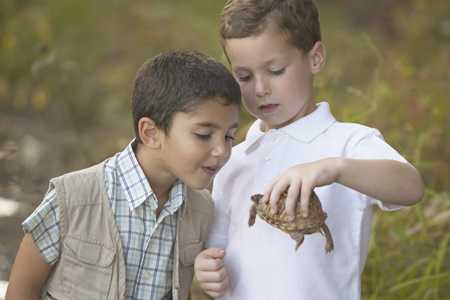Turtles Kept as Pets
Is a turtle the right pet for your family?

Did you know that the sale of turtles less than 4 inches has been banned in the United States since 1975? This is because turtles pose a high risk of spreading disease, especially to children. The ban by the U.S. Food and Drug Administration (FDA) has prevented an estimated 100,000 cases of salmonellosis annually in children. This ban prohibiting the sale of small turtles likely remains the most effective public health action to prevent turtle-associated salmonellosis.
Despite the health risk, turtles have become very popular pets in recent years. Their slow movements and tough colorful shells may make them seem like the perfect family pet. However, turtles carry potentially dangerous bacteria called Salmonella.
Don't be fooled
Just because you can't see the bacteria doesn’t mean they aren’t there. Salmonella are naturally occurring bacteria in turtles and those with Salmonella usually do not appear sick in any way. In addition, turtles do not shed Salmonella all of the time. So, just because a turtle might have one negative test for Salmonella doesn’t mean that they are not infected. It could mean that the turtle was not shedding Salmonella on the day it was tested.
Salmonella bacteria cause a human disease called salmonellosis. Reptiles, including turtles, transmit an estimated 74,000 cases of salmonellosis to people in the United States annually. Amphibians, including frogs, toads, newts, and salamanders, can also transmit salmonellosis. Some cases may cause severe illness, hospitalization and even death in susceptible people such as children under 5, the elderly, and people who have lowered natural resistance to disease due to pregnancy, cancer, chemotherapy, organ transplants, diabetes, liver problems or other diseases.
There have been a number of turtle-associated salmonellosis cases recently in the United States 1, 2, 4.
What can be done to prevent turtle-associated salmonellosis?
- Do not have a turtle in any household that includes children under 5, the elderly, or people who have lowered natural resistance to disease due to pregnancy, cancer, chemotherapy, organ transplants, diabetes, liver problems or other diseases. A family expecting a child should remove any pet reptile or amphibian from the home before the infant arrives.
- Remember, turtles are cute, but contaminated. Handle all turtles and surfaces that have come in contact with turtles as if they are contaminated with Salmonella, because there is a good possibility that they are.
- Wash hands thoroughly with soap and water immediately after handling turtles or their cages, or after contact with pet feces. Do not touch your face, other people or any surface until hands are washed.

Person washing their hands with soap and water.
- Wash surfaces that the turtle or its cage has come in contact with.
- Separate the turtle from possible contact with food:
- Do not allow turtles to roam freely about a home or living area, and especially do not allow them in food preparation areas.
- Kitchen sinks should not be used to bathe turtles or to wash their dishes, cages, or aquariums.
- If bathtubs are used for these purposes, they should be cleaned thoroughly and disinfected with bleach.
- Separate the turtle from contact with high-risk individuals:
- Don't handle a turtle and an infant (e.g., feed, change diaper) at the same time.
- Wash hands thoroughly with soap and water before handling an infant or preparing a baby bottle.
- Persons at increased risk for infection or serious complications from salmonellosis (e.g., children under 5, the elderly, or people who have lowered natural resistance to disease due to pregnancy, cancer, chemotherapy, organ transplants, diabetes, liver problems or other diseases) should avoid contact with reptiles and amphibians and any items that have been in contact with them 3.
- Turtles should not be allowed in childcare centers or nursing homes.
- Turtles in public settings (e.g., zoos and exhibits) should be kept from direct or indirect contact with patrons except in designated animal-contact areas equipped with adequate hand-washing facilities.
- Food and drink should not be allowed in animal contact areas.
References
- Salmonellosis Associated with Pet Turtles — Wisconsin and Wyoming, 2004
Morbidity and Mortality Weekly Report. March 11, 2005 / 54(09);223-226 - Reptile-associated salmonellosis—selected states, 1998-2002
MMWR Morbidity and Mortality Weekly Report. December 12, 2003 / 52(49);1206-1209. - Rowe SY, Rocourt JR, Shiferaw B, Kassenborg HD, Segler SD, Marcus R, Daily PJ, Hardnett FP, and Slutsker L; Emerging Infections Program FoodNET Working Group. Breast-feeding decreases the risk of sporadic salmonellosis among infants in FoodNet sites. Clinical Infectious Diseases. 2004 Apr 15;38 Suppl 3:S262-70.
- Turtle-Associated Salmonellosis in Humans — United States, 2006–2007
Morbidity and Mortality Weekly Report. July 6, 2007 / 56(26);649-652.
- Page last reviewed: October 1, 2015
- Page last updated: October 1, 2015
- Content source:


 ShareCompartir
ShareCompartir